A Short History of the Hemingray Glass Co. - Part 4 of 4
by H. G. "BEA" HYVE
Reprinted from "INSULATORS - Crown Jewels of the Wire", January 1982, page 20
Ralph Hemingray died in 1920, leaving the post of president to a
son-in-law, Philip W. McAbee. He held this position for the remainder of the
company's existence, and on into the first year of the Owens-Illinois era.
McAbee had been an Army colonel during World War I, and under his far-seeing
direction the plant's operations became mechanized. About 1920 the first
automatic insulator machines with multiple molds were installed, replacing the
old hand presses which only contained one mold.
Because of this mechanization of
the operations, production increased. So in order to continue to employ a
maximum number of people, the company added to its products a line of glass
bottles in the last half of the 1920's, which proved to be a very successful
venture. And 1925 brought the first automatic container machines where glass was
blown into a mold for bottles automatically instead of by hand. Now 60 bottles a
minute could be made.
By the early 1930's many businesses successful in earlier
years were now doing poorly due to the Great Depression. Those who did not want
to struggle any longer either closed their doors or sold out. The state of the
economy at that time could have been a reason for the turning of the final page
in the company's history along with mismanagement's being another possible
cause. In any case, in 1933 the Hemingray Glass Co. was purchased by
Owens-Illinois, who took over active operation in June of that year. And so
ended 85 years of glassmaking by a company known throughout the world for its
excellence.
Although O-I continued making insulators at Muncie, 1934 saw the
development of a new architectural product -- glass building block. Soon after
World War II the use of cables and other electrical advances caused a marked
decrease in the demand for insulators. Ern Parkison, a former employee of the
Hemingray Glass Co. (and the last man hired by them, in 1931) says that
insulator production at O-I was discontinued in 1966, after having fallen off to
almost nothing. And in 1969 the name "Hemingray" was not listed for
the first time in the O-I directory. By this time the Muncie plant was
concentrating entirely on the production of television face panels.
Over the 85
years of its existence, and especially in its early years, the Hemingray Glass
Co. produced an astounding variety of items. If it was pressed or blown
glassware, Hemingray probably made it at one time in their history. According to
company ads which have survived, a list of some of the items reads as follows:
Lamps, lanterns, fruit jars, demijohns (beverage bottles in basketwork), carboys
(large glass bottles for industrial chemicals, enclosed in wooden crates),
brandies, flasks, hock wines (tall, slim bottles), beer bottles, mineral water
bottles, candy jars, fish globes (bowls), insulators, tumblers, decanters,
battery jars, electric light globes, packing bottles, lamp glasses, apothecary
shop (pharmacy) furniture, perfumery glass, glass milk pans, cut glass, and so
on. Quite an impressive list!
EPILOGUE
What eventually happened over the years
to the three Hemingray plant sites? The buildings around the Hammond St. site
have been replaced at least twice, perhaps three times, since Gray &
Hemingray's glass plant was there. A very large office building is under
construction in the area now, which will probably eliminate Hammond St.
altogether.
The Covington plant was listed for the last time in the city's
directory for 1918-19. The buildings were occupied by Fries & Son in
September of 1922. They were a steel construction and engineering company,
makers of jail and prison equipment, and were there until the 1960's. Escue
Datsun now occupies the remaining buildings.
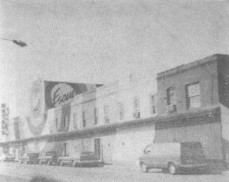
(Looking west on 2nd St.)
|
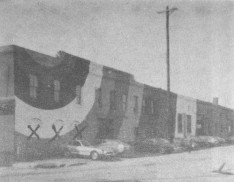
(Looking north on Madison)
X = Hemingray's offices |
Hemingray Glass Co. buildings at Covington, 1981
(Courtesy of Franklin Jaquish)

Muncie plant and offices at left
(c. early 1920's)
(Courtesy of Mike Sovereign and Dick Bales)
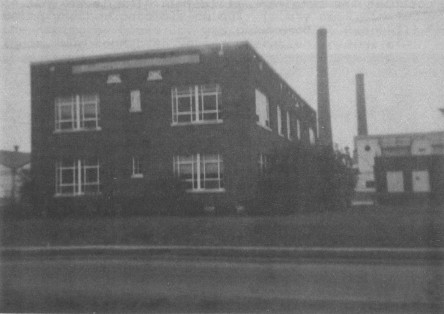
The same scene today
(Cement panel at top of building reads,
"HEMINGRAY GLASS COMPANY")
The levee that protects the city of
Covington runs across the grounds of the old plant. According to a recent
clipping from The Kentucky Post, the old Hemingray Glass Co. buildings at 2nd
and Madison were slated for demolition in the future to make way for a
riverfront redevelopment project. But on the night of November 2, 1981, this
landmark in glassmaking history burned to the ground, and is now gone forever.
PERSONAL GLIMPSES
Of the three Hemingray plant sites, I have been able to visit two --
Covington and Muncie. (I didn't know about the Hammond St. site yet when I
was in the area in 1976, or I would have looked it over also). At Covington, we
were able to walk around the remaining buildings, which included the old offices
of the Hemingrays, and we picked up shards of glass out in back by the levee. We
took a few pictures, but didn't go inside the buildings.
I visited the site at
Muncie last May. There is a 24 hour watch around the grounds, headed by Ruth and
Jim Crawford, who, with kind permission from their boss, Mr. Bud Westfall of
Sheller-Globe, took me on a tour of the plant. They spent most of the day
showing me the remaining old buildings and equipment, explaining the glassmaking
process and showing me the various places where it was all done.
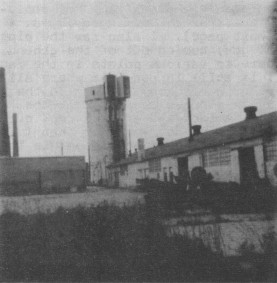
Raw materials silo (tall building)
Many things
were removed or added when O-I took over in 1933, but some of the original
Hemingray construction still exists.
Among the many things I saw, was the batch
mixer (or raw materials silo), where the ingredients for making glass were
stored, weighed, and mixed. (The silo is pictured on the previous page). From
there the ingredients were trucked over to the furnaces. "A" furnace,
built in 1888, and "B" furnace, built in 1904, are still there. It was
in these furnaces that the glass was melted and poured into the insulator mold
machines (which have long since been removed). Then the newly-formed insulators
were put in an annealing lehr (slow-cooling, heat-treat oven). From there they
were taken by conveyor belt to the second floor, where they were placed on wire
racks until cool enough for washing in cement troughs (which are still there).
Then they were packed in wooden barrels for shipping.
Ruth's grandfather worked
in this second floor department, loading still-warm insulators onto the racks,
using heavy gloves. He came to work for Hemingray in 1908 at the rate of 12
cents an hour, and worked ten to twelve hours a day.
I was also shown the cullet
shed, and was fortunate to be able to obtain a sign from that building which was
left over from the Hemingray days. (See photos on the next page). I also saw the
pipes in which the natural gas, coming out of the ground, was carried from there
to various points in the factory. And the well is still in use from where all
the water for the plant was taken. Here also the workers would get a few minutes
respite from the heat and noise of the factory and enjoy a cool cup of water. I
saw and learned so much more than I have recounted here, but it would be
impossible to tell about all of it in this story.
It is sad to realize that all
of the Hemingray plants will soon be gone. All we will have are the memories
that remain, and the words recorded by historians over the years, along with
whatever photos were preserved. But we as insulator buffs will always have the
legacy of glowing, sparkling glass that the Hemingray Glass Co. has left us. The
color and beauty of their insulators will bring delight to the eyes of
collectors for many years to come.
The following words are taken from a 1920
company bulletin: "...the only real test of any product (is) years of
satisfactory service." Time has verified the truthfulness of their
statement beyond the shadow of a doubt. Their insulators have passed that test.
Some of them are still on the job; some have retired. But the name
"Hemingray" will be with us for a long time.
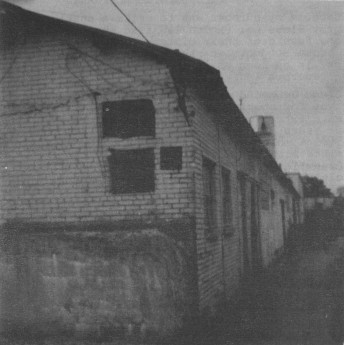
Cullet shed where glassmaking material was stored
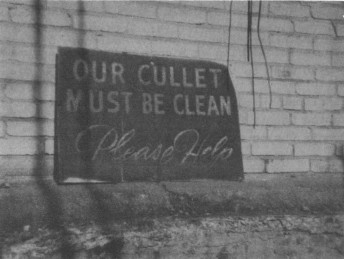
Sign left over from Hemingray era
"Our cullet must be clean
Please Help"
ACKNOWLEDGMENTS AND
THANKS
Because my purpose was to write a short history of the Hemingray Glass
Co. (which isn't so short after all), there are many facets of their history that
I have omitted. I will leave those subjects to other Hemingray historians.
However, my story is as long as it is because of the help of the following
generous individuals:
- Glenn Drummond of Cincinnati, OH: I want to sincerely
thank you for sharing your knowledge of Hemingray history with me. I feel very
fortunate to have reaped the benefits of your years of research, and I
appreciate your help and encouragement more than I can say. This story would
have been a slim one without your generosity.
- Franklin Jaquish of Covington,
KY: Thank you so much for helping me research the Covington years and for
sending me articles, maps, photos, and old company ads from directories, plus
making countless trips to libraries and various places. You have been a
tremendous help to me.
- Ruth and Jim Crawford of Muncie, IN: Thank you for
sharing your time and knowledge with me, and for the tour of the Muncie plant.
And Ruth a special thanks to you for finding the photo of Ralph Hemingray, and
for answering my many questions and taking photos for me, among other things.
- Mike Sovereign of Bartlett, IL: Thank you most sincerely for photographing your
1920's photo of the office and plant at Muncie, and for sending me so much
material on Hemingray history, including copies of old ads and catalogs.
- Dick
Bales of Aurora, IL: Thanks go to you for granting permission to use Mike's
photo of the old Muncie plant which was originally in your possession, along
with the old company ads and catalog reprints.
- John Macken of Muncie, IN:
Thank you for sharing your reminiscences of Ralph Hemingray, and for patiently
explaining to me the glassmaking process as it was done at Muncie in the early
days.
- Ern Parkison of Muncie, IN: I thank you for sending me speeches and
other material on the Hemingray Glass Co. at Muncie, and for sending me a copy
of the company invoice.
I also want to thank these societies who were so very
helpful to me:
- Cincinnati Historical Society, Cincinnati, OH.
- Kenton County
Public Library, Covington, KY.
- Muncie Public Library, Muncie, IN.
And one
publication not cited in the text:
History of Delaware County Indiana, Vol. II,
Frank D. Haimbaugh, 1924. (Photo of Ralph Hemingray).
|
